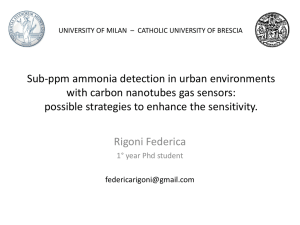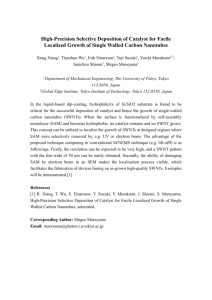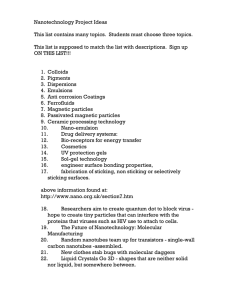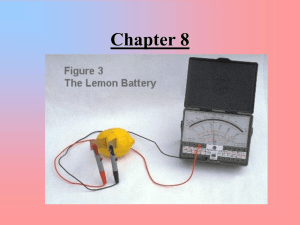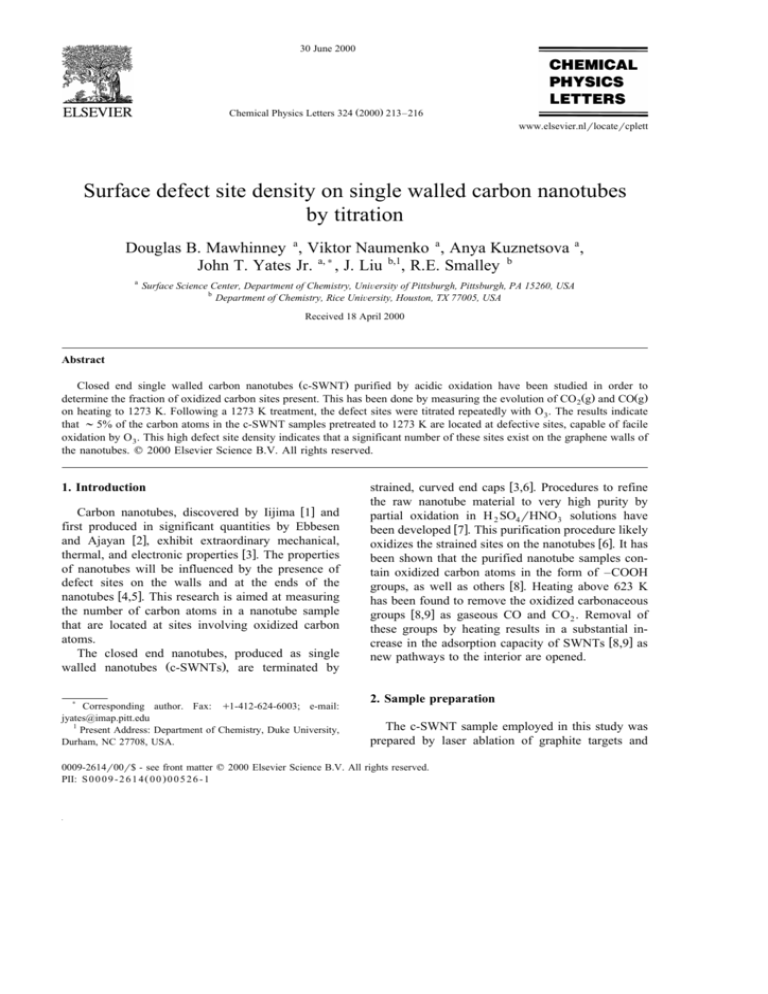
30 June 2000
Chemical Physics Letters 324 Ž2000. 213–216
www.elsevier.nlrlocatercplett
Surface defect site density on single walled carbon nanotubes
by titration
Douglas B. Mawhinney a , Viktor Naumenko a , Anya Kuznetsova a ,
John T. Yates Jr. a,) , J. Liu b,1, R.E. Smalley b
a
Surface Science Center, Department of Chemistry, UniÕersity of Pittsburgh, Pittsburgh, PA 15260, USA
b
Department of Chemistry, Rice UniÕersity, Houston, TX 77005, USA
Received 18 April 2000
Abstract
Closed end single walled carbon nanotubes Žc-SWNT. purified by acidic oxidation have been studied in order to
determine the fraction of oxidized carbon sites present. This has been done by measuring the evolution of CO 2 Žg. and COŽg.
on heating to 1273 K. Following a 1273 K treatment, the defect sites were titrated repeatedly with O 3. The results indicate
that ; 5% of the carbon atoms in the c-SWNT samples pretreated to 1273 K are located at defective sites, capable of facile
oxidation by O 3. This high defect site density indicates that a significant number of these sites exist on the graphene walls of
the nanotubes. q 2000 Elsevier Science B.V. All rights reserved.
1. Introduction
Carbon nanotubes, discovered by Iijima w1x and
first produced in significant quantities by Ebbesen
and Ajayan w2x, exhibit extraordinary mechanical,
thermal, and electronic properties w3x. The properties
of nanotubes will be influenced by the presence of
defect sites on the walls and at the ends of the
nanotubes w4,5x. This research is aimed at measuring
the number of carbon atoms in a nanotube sample
that are located at sites involving oxidized carbon
atoms.
The closed end nanotubes, produced as single
walled nanotubes Žc-SWNTs., are terminated by
)
Corresponding author. Fax: q1-412-624-6003; e-mail:
jyates@imap.pitt.edu
1
Present Address: Department of Chemistry, Duke University,
Durham, NC 27708, USA.
strained, curved end caps w3,6x. Procedures to refine
the raw nanotube material to very high purity by
partial oxidation in H 2 SO4rHNO 3 solutions have
been developed w7x. This purification procedure likely
oxidizes the strained sites on the nanotubes w6x. It has
been shown that the purified nanotube samples contain oxidized carbon atoms in the form of –COOH
groups, as well as others w8x. Heating above 623 K
has been found to remove the oxidized carbonaceous
groups w8,9x as gaseous CO and CO 2 . Removal of
these groups by heating results in a substantial increase in the adsorption capacity of SWNTs w8,9x as
new pathways to the interior are opened.
2. Sample preparation
The c-SWNT sample employed in this study was
prepared by laser ablation of graphite targets and
0009-2614r00r$ - see front matter q 2000 Elsevier Science B.V. All rights reserved.
PII: S 0 0 0 9 - 2 6 1 4 Ž 0 0 . 0 0 5 2 6 - 1
214
D.B. Mawhinney et al.r Chemical Physics Letters 324 (2000) 213–216
purified by the HNO 3rH 2 SO4 method w7x to more
than 90% pure, as measured by SEM. The nanotubes
have a distribution of diameters near that of a Ž10,10.
˚ . w7x. The SWNTs were suspended in
tube Ž13.6 A
methanol Žsample A. or in N, N X-dimethylformamide
Žsample B.. The samples were prepared for transmission IR studies w8,10,11x by evaporating the suspension onto a sample support, consisting of CaF2 powder pressed into the openings of a tungsten grid and
then pretreated in vacuum to 1273 K. The sample
was then heated in vacuum at 373 K for 20 h to
remove residual solvent, reaching a base pressure of
1 = 10y6 Torr.
3. Results and discussion
The carbon nanotubes were then heated to 1273 K
in the closed cell. Both CO 2 and CO were observed
to evolve, as expected w8,9,12x. Typical infrared
spectra of the gaseous CO 2 and CO are shown in
Fig. 1. The integrated area under the unresolved
rotational wings of each gas was measured and the
number of carbon atoms evolved was deduced from
calibration plots of integrated absorbance versus gas
pressure, shown in Fig. 2. The production of CO 2 Žg.
and COŽg. is accompanied by the loss of infrared
absorbance from various carbonyl groups present on
the nanotube surface, as shown in Fig. 3. Control
heating experiments without the nanotube deposit
did not yield measurable CO 2 Žg. or COŽg.. The
Fig. 1. Typical infrared spectra of the gaseous CO 2 and CO
evolved from the c-SWNT sample following the various stages of
the experiment. Spectrometer resolutions 4 cmy1 .
Fig. 2. Calibration for measuring the pressure of CO 2 and CO
gases from their integrated absorbance.
production of CH 4 Žg. w8,9x was undetected by infrared spectroscopy, and calibration of the CH 4 detection level indicates that the carbon evolution as
CO 2 Žg. and COŽg. accounts for at least 94% of the
evolved carbon.
Carbonyl surface functionalities may be produced
repeatedly after the 1273 K treatment by reoxidation
of the nanotubes with O 3 at 300 K. This facile
oxidation reaction has been reported previously w10x,
and a typical spectrum of the ozonized nanotubes
can be found there. After evacuation, these O 3-treated
samples were again heated to 1273 K in the closed
cell, and CO 2 Žg. and COŽg. were evolved and measured by infrared spectroscopy. This ozonation procedure was repeated three times for sample A and
twice for sample B. The results of these experiments
can be seen in Fig. 4, where an average of 3.6 = 10 17
Žsample A. and 1.4 = 10 17 Žsample B. carbon atoms
Fig. 3. Carbonyl region of c-SWNT infrared spectrum before and
after thermal treatment to 1273 K.
D.B. Mawhinney et al.r Chemical Physics Letters 324 (2000) 213–216
Fig. 4. The amount of carbon evolved as gaseous CO 2 and CO
following the various treatments.
was removed in each ozone-induced oxidation–reduction cycle.
In order to evaluate the atomic fraction of carbon
that is removed from the defective oxidized carbon
sites by the various treatments, it was necessary to
measure the total carbon content of the nanotube
samples. The remaining carbon atoms were therefore
oxidized at 973 K w7,13x in O 2 initially at 20 Torr.
Following oxidation, the amount of evolved CO 2 Žg.
and COŽg. were measured by infrared spectroscopy.
The calibration for this measurement was performed
in the presence of excess O 2 to mimic the measurement conditions. It was found that sample A originally contained 4.4 = 10 18 carbon atoms and sample
B contained 4.5 = 10 18 carbon atoms ŽFig. 4.. A
small correction Ž- 1%. to the measurement of
evolved carbon was made to account for CO 2 Žg. and
COŽg. originating from the tungsten grid during the
complete nanotube oxidation. Complete nanotube oxidation is accompanied by the return of the infrared
absorbance to the background level characteristic of
the clean CaF2 support and the disappearance of the
black deposit.
These measurements permit one to calculate the
fraction of carbon atoms that exist as oxidized species
on the SWNT samples. The fraction of carbon removed in the initial heating of the first acid-purified
SWNT sample Žsample A. is 4%. The fraction of
carbon removed in the initial heating of the second
acid-purified SWNT sample Žsample B. is also 4%.
Because a small fraction of carbonyl mode absorbance remains after the 1273 K treatment ŽFig. 3.,
215
these measurements represent a lower limit for the
fraction of oxidized sites.
The measurements of the fraction of oxidized
carbon atoms following the sequential ozone treatments average 5.5 " 2.5% over the 5 independent
measurements, and no significant trend in the O 3
oxidation yields is observed as the experiment is
repeated. It has been shown by IR and Raman spectroscopic measurements that neither the ozone treatment or 1273 K-heating affects the basic SWNT
structure w9,10x. It could be argued that the initial
heating of the acid-treated SWNT sample results in
the decomposition of impurity species, still present
after purification, resulting in the observed evolution
of CO 2 Žg. and COŽg. from the original samples.
However, the subsequent O 3-induced oxidation most
likely results from O 3 attack at defect sites on the
SWNT walls and end caps. The lack of a trend
toward decreasing CO 2 Žg. and COŽg. production
from the SWNT samples during the sequences of O 3
oxidation and thermal reduction suggests that only
the defect sites are probed, and that a decreasing
quantity of impurity is not being probed.
4. Conclusions
These measurements therefore indicate that for
the SWNTs purified by acidic oxidation and heated
to 1273 K, the graphene sheet walls contain a
fractional defect level of 5.5% " 2.5%, as measured
by the presence of oxidized carbon atoms at these
sites. For long SWNTs, the fraction of defect sites
attributable to the end caps is much smaller than
5.5%. These defect sites on the graphene sheet walls
of the 1273 K-treated SWNTs will have important
implications in the electrical properties of the nanotubes w14x and in the transport of molecules into the
nanotube interior w8,9x.
Acknowledgements
We gratefully acknowledge support of the work
by The Army Research Office and by DARPA under
grant number DAAD16-99-C-1036.
216
D.B. Mawhinney et al.r Chemical Physics Letters 324 (2000) 213–216
References
w8x
w1x S. Iijima, Nature 354 Ž1991. 56.
w2x T.W. Ebbesen, P.M. Ajayan, Nature 358 Ž1992. 220.
w3x M.S. Dresselhaus, G. Dresselhaus, P.C. Eklund, Science of
Fullerenes and Carbon Nanotubes, Academic Press, San
Diego, CA, 1996.
w4x L.S. Singer, Proceedings of the 5th Carbon Conference, vol.
2, Pergamon, New York, 1961, p. 37.
w5x S.M. Lee, Y.H. Lee, Y.G. Hwang, J.R. Hahn, H. Kang, Phys.
Rev. Lett. 82 Ž1999. 217.
w6x M.S.C. Mazzoni, H. Chacham, P. Ordejon,
´ D. Sanchez-Portal,
´
J.M. Soler, E. Artacho, Phys. Rev. B 60 Ž1999. R2208.
w7x A.G. Rinzler, J. Liu, H. Dai, P. Nikolaev, C.B. Huffman, F.J.
Rodrıguez-Macıas,
´
´ P.J. Boul, A.H. Lu, D. Heymann, D.T.
w9x
w10x
w11x
w12x
w13x
w14x
Colbert, R.S. Lee, J.E. Fischer, A.M. Rao, P.C. Eklund, R.E.
Smalley, Appl. Phys. A 67 Ž1998. 29.
A. Kuznetsova, D.B. Mawhinney, V. Naumenko, J.T. Yates,
Jr., J. Liu, R.E. Smalley, Chem. Phys. Lett. 321 Ž2000. 292.
A. Kuznetsova, J.T. Yates, Jr., J. Liu, R.E. Smalley, J.
Chem. Phys., in press.
D.B. Mawhinney, V. Naumenko, A. Kuznetsova, J.T. Yates
Jr., J. Liu, R.E. Smalley, J. Am. Chem. Soc. 122 Ž2000.
2382.
T.H. Ballinger, J.C.S. Wong, J.T. Yates Jr., Langmuir 8
Ž1992. 1676.
Y. Ottake, R.G. Jenkins, Carbon 31 Ž1993. 109.
L.S.K. Pang, J.D. Saxby, S.P. Chatfield, J. Phys. Chem. 97
Ž1993. 6941.
P.G. Collins, K. Bradley, M. Ishigami, A. Zettl, Science 287
Ž2000. 1801.




